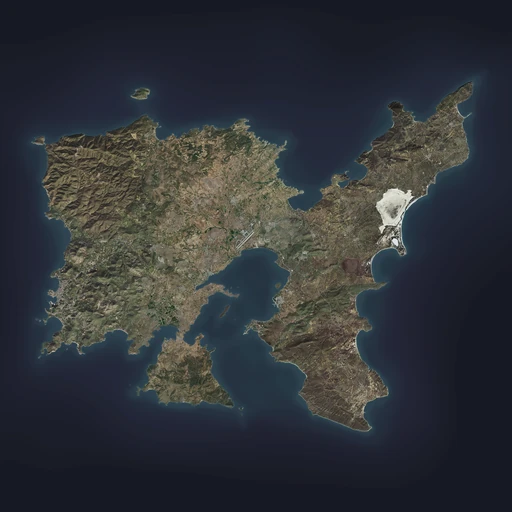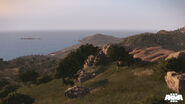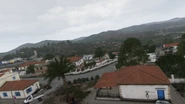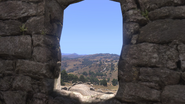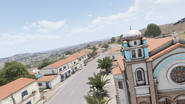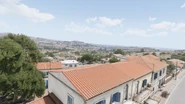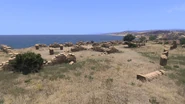Altis is a playable terrain in ArmA 3.
Overview
| « | Clocking-in at 270 km², Altis truly is the star of Arma 3. From expansive cities to rolling hills, from wind farms to solar farms, whether steamrolling your tank across the southern plains, or waging asymmetric warfare from the northern hills, the Altis landscape lends itself to some of the most detailed locales and varied engagements. Official ArmA 3 website
|
» |
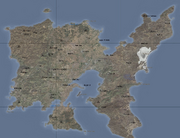
Topographical map with major settlements and POIs labelled
The mainland island of the Republic of Altis and Stratis, Altis as a whole consists of five regions: the East, South-East, Central, West, and the South-West:
- Beginning with the city of Paros, the East goes all the way to the edge of the north-eastern corner of the island.
- The South-East starts at the cities of Rodopoli and Charkia, ending at the south-eastern tip of the island at Feres and Selakano. Pyrgos serves both as the regional and national capital.
- The second smallest region out of the five, the Central section of the island ranges from the village of Kalithea on the eastern edge to the cities of Frini and Athira to the north. Athira serves as the regional capital of the sector.
- The largest of the regions (landmass-wise), the border for the West begins at the city of Zaros to the south and ranges through to the cities bordering the central region; Poliakko and Neochori on the east, up to the village of Ifestiona in the north. Kavala serves as the region's capital.
- The smallest region, the South-West only consists of remote villages and is mostly surrounded by water. It begins at the small strip of land running along the south of the western region's border, which connects it to the mainland at Drimea.
Every single region (except for the South-West) is connected via three main highways that run through each of them: one for the West and Central regions, another for the East, and a third for the South-East.
The South-West region can be accessed via a small dirt road which is linked to an arterial road that splits off from the main western highway.
Geography

Rocky hills and steep valleys are a common sight all across Altis
Covering an area of 270.5 square kilometres, Altis is a volcanic island with a corrugated and mostly rocky landscape. Scattered throughout the more remote regions of the archipelago are large pine forests and the occasional outcrop of tree groves. A tiny desert also exists north of the village of Abdera and is unique for its micro-environment condition.
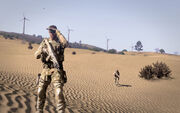
The mini desert north of Abdera
The length of Altis' coastline extends well over 200 kilometres, with a total of twenty bays that surround it as well. The largest of them, the Gulf of Pyrgos, is located in the central sector and partially divides both halves of the island.
Three inland bodies of water, Limni, Ochrolimni, and Almyra also exist. Periodically inundated and flooded in all seasons except for summer, they are entirely saltwater-based. During the summer, the cracked surfaces become completely hard and dry.
The highest point on the island is located at the peak of Thronos at the north-western section of Altis (near the abandoned village of Oreokastro). Measured at a height of 350 metres above sea level, the ruins of a castle built by Arabian warlords during the Middle Ages remain on top of it.
Settlements
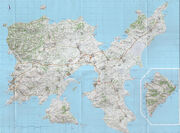
Simplified topographic map with major roads displayed
Including all cities, towns, and villages, there are a grand total of forty nine settlements established on Altis. Of these, twenty two are considered to be major cities. One of them, Pyrgos, is established as the capital city of the nation.
Aside from the larger cities, twenty seven villages/towns are scattered throughout each sector of the island. Numerous military installations and outposts are also littered throughout Altis, usually distinguished by their tall observation towers and research domes.
Up to one hundred and sixty five chapels are present on Altis, with many more being roadside/hilltop Greek Orthodox shrines. The chapel located atop Agia Stemma (a mountain in the eastern region) is particularly notable for its hard-to-access but great viewing position.
East
Delfinaki is a small village built along the main eastern highway. A road just on its eastern limit connects it to the military base built above the hilltop cresting Delfinaki itself (to the north). There are no gas stations built in Delfinaki.
Less than a few hundred metres to the south-west of Delfinaki, Ioannina is another small village that is built along a stretch of road connected to the eastern highway.
It has a gas station built right next to the main road. The smaller road that Ioannina is built at ultimately terminates at the Temple of Iraklia ruins to the north-west, which overlooks Pefkas Bay.
One of the twin cities in the East that borders the southern region, Kalochori is located directly south of Paros' city centre. A church is built near the centre of Kalochori.
Several smaller dirt roads link to the Limni and Ochrolimni saltwater lakes/marshes in the south and east (respectively). One road in the east diverts to Cap Thelos, which contains a church. Another to the south (and east of Limni) links to the Surf Club and Cap Kategidis, which are both coasted along Thelos Bay.
There are no gas stations built in Kalochori.Located on the north-easternmost corner of the island, Molos is the final city after Sofia that the main highway connects to and terminates at.
A small dirt road to the east links it to Polemistia which can be used to access the Molos Bay, while other roads can be used to reach the Molos Airfield to the north. One road also connects Molos to Limnichori (to the west), which is coasted to the Galana Nera Bay.
There are no gas stations built in Molos.A city built on the regional border with the South, Paros is a twin city of Kalochori just to its south.
The main eastern highway runs through Paros, and the city itself has a gas station built on its city limits (at the south-west). A dirt road connects it to Agios Georgios in the north which ultimately ends at the Amphitheater ruins overlooking Pefkas Bay (an unmarked weapons research facility is also present along the way). Meanwhile, a smaller eastern road diverts to Kalochori instead.
Built on the north-eastern corner of the island, Sofia is the second last city in the East. The main highway runs through the city centre, with a military facility (complete with radar dome) also built above the hill overlooking Sofia a few metres to the north.
A gas station is present in the city centre along with a church. Two roads connect Sofia to Gatolia in the east, which serves as a power station for a large solar farm just on its outskirts.
South-East
One of the larger settlements in the South-East, the city of Chalkeia is built along the main southern highway.
Notable for being built in the centre of three large hills, Chalkeia's terrain is terraced while the city itself contains two churches and a gas station. Two roads on the east side can be used to reach Chalkeia Bay, while another can be used to reach the ancient ruins at Aktinarki (which overlooks the bay).
Due to the recent years of global climate change, the beaches along Chalkeia's coast are an especially popular destination for surfers around the world as it provides some of the best waves in the central Mediterranean.
Built along two arterial roads in the north, Charkia is one of the larger cities bordered to Central Altis.
Two churches are built in the city. It forms a terminus where the arterial roads from Rodopoli to the north-east and the village of Nifi intersect. The arterial road from Rodopoli reroutes back-and-forth from the eastern and southern main highways.
There are no gas stations built in Charkia.Located due east of the capital Pyrgos, Dorida is a large town that contains a church and is built along the main southern highway.
Two large hills are crested to the south which the main highway cuts through. It links directly to the city of Charkia, while smaller roads (intermeshed with open fields) connect to the Limni saltwater marsh to the north-east.
There are no gas stations built in Dorida.The city of Feres forms the terminus of the main southern highway.
A church is located in the centre of the city, while two alternate roads link it to the village of Selakano in the south-west and church at Agia Pelagia to the south-east. The road to Agia Pelagia can also be used to gain access to the Mazi Bay.
The Feres Airfield is located just left of the city centre, and consists of a few concrete buildings and a dirt-based runway. A gas station is also built just next to the road linking Feres to Selakano.
The first city located along the bottom-half of the South-East region, Panagia is built along the main southern highway.
Two dirt roads from both the city itself and the northern branch of the highway can be used to reach the hilltop wind generator farms above the hilltops to Panagia's north-west. Another dirt road east of the city centre, link it to the wind farms east of it instead. A fourth dirt road can be used to access the remote fishing village of Livadi to its south-west.
There are no gas stations built in Panagia.The capital of the Republic of Altis and Stratis, Pyrgos is one of the most densely populated settlements on the mainland (after Kavala in the West).
A gas station is located to the south of the city's limits. Two military installations are built near the city itself; one in the north-east and another in the south. A small road links it to the remote hilltop village of Faronaki to the south-west, while the main southern highway (north) can be used to reach Chelonisi Island.
A dirt road that diverts from the road to Faronaki can be used to reach the remote village of Ekali due south of Pyrgos. The entire city meanwhile, is coasted to the Gulf of Pyrgos and has a large promenade/harbour that runs along the length of its beaches.
The remains of the ancient Pyrgos Castle can be found between the harbour and the nearby government office complexes, which serves a particularly popular tourism attraction for the city.
The northernmost city of Rodopoli is built along the main highway that links to the East.
A church is built close to the city's centre. The small village of Agios Petros can be accessed via a road to the north, while an arterial road links it to the city of Charkia just slightly to the south-west.
There are no gas stations built in Rodopoli.A small village south-west of Feres, Selakano is the furthermost settlement located on the south-eastern peninsula of Altis.
A dirt road links Selakano to the Mazi harbour to the south-east, which can be used to access the Mazi Bay itself. The north-western dirt road can be used to reach the Livadi fishing village to Selakano's north-west (connected to via the city of Panagia).
Ihere are no gas stations built in Selakano (the gas station is considered to be a part of Feres).Central
Located to the south-east of the Altis International Airport, the village of Anthrakia borders the South-East region.
There are two churches built in the village, and is actually constructed along a small road that breaks off from the main southern highway. The village has a small harbour to its south that is coasted to the Gulf of Pyrgos. Dirt roads on the east and north can be used to reach the cities of Rodopoli and Telos (respectively).
There are no gas stations built in Anthrakia.Located due north of the Altis International Airport, the city of Athira is one of the Central region's largest settlements. It is situated along the border of the western side of Altis, and is also considered to be the capital of the Central region.
A gas station exists on the southern route of the road that links it to Gravia, while a church is constructed in the city centre. Athira forms a terminus where the roads from the city of Frini (north of Athira) and the village of Koroni (to the west) intersect. The village of Ifestiona (in the north-west) can also be reached via another dirt road extended on the city's north.
A large industrial factory/depot is built on the city's limits to its east. The tip of the Central region can be reached via another road that breaks off from the route to Frini to Nychi. The fishing village of Agia Triada (also located to the north-east) can be accessed via a dirt road that extends directly from Athira's city centre.
Lastly, a small military outpost is constructed inside Athira, though it is closed-off from the surrounding civilian structures.
Located even further north of the Altis International Airport, the city of Frini is a settlement that is built along the border with the western region.
The secondary road that extends from Athira terminates at Frini. A military outpost is constructed just to Frini's north-west, while a large pine forest is situated at the city's north. Both can be accessed via smaller dirt roads that extend towards both locations.
There are no gas stations built in Frini.The city of Gravia is built along two arterial roads that split off from cities of Lakka (to the south-west), Telos (to the east), and Athira (to the north).
A gas station is set up close to the intersection that leads to Gravia (on the eastern side of the main western highway), while a church is also built in the city centre. The Altis International Airport can be accessed via the highway due south of Gravia itself, with one small dirt road also leading straight to the main terminal. Meanwhile, the large industrial harbour used by the airport is present just to Gravia's south. It is coasted to the Gulf of Pyrgos.
The small village of Kalithea is located due east of Telos, and sits on the border with the southern region of the island.
A relatively tiny fishing village, Kalithea is used to access the Kalithea Bay itself. A church is constructed in the centre of the village, as is a small harbour. The village itself is built along a small road that breaks off from the main eastern highway.
The "Monument of Kalithea" is also notable for being built in the village. It commemorates an old legend pertaining to Altis' recent past.
There are no gas stations built in Kalithea.The city of Telos is located due east of the Altis International Airport.
Telos is built along the main eastern highway which runs through it. One gas station is constructed on the crossroads to the west (near the airport) that splits between the southern and eastern highways, while two churches are also present in the city itself. A major military research facility is also built on Telos' outskirts (directly to the south).
West
Abdera is a mountain village located to the north-east of Syrta.
Constructed in-between a valley separated by mountains on all sides, Abdera is quite remote and only has a single paved road linking it to any other major settlement besides Galati to the south.
A stretch of road heading north passes by a small rough surface airstrip along the way to the harbour at Krya Nera further down the valley. Krya Nera itself is coasted to the Ammolofi Bay.
There are no gas stations built in Abdera.A tiny village located on the northern outskirts of Kavala, Aggelochori mainly serves to mark the limits of the former capital.
Lined with hilly terrain, Aggelochori mostly consists of a few clustered civilian houses with a soccer field placed in-between. A small rock path on the western side leads directly to an enclosed beach below it. The main road that cuts through it (originating from Kavala) links directly to Negades to the north.
There are no gas stations built in Aggelochori.Agios Dionysios is a city located directly in the middle of the western region.
Built along the main western highway, Agios Dionysios is one of the bigger settlements in the region. It is situated above a fairly large valley, is south-west of the village of Orino, is due west of Lakka, and is north-west of the town of Alikampos.
Agios Dionysios has a gas station located on the western side of the city while a church is on its eastern side. One dirt roads in the south leads to the Xirolimni Dam due south of the city, whereas another will lead to the factory complex/junkyard just on the city's south-eastern limits. The same dirt road can also be used to reach Alikampos and runs through several more hills.
Road travellers are advised to slow down on the western end of the city, as a U-shaped bend breaks the highway and can cause potential traffic accidents at high speeds.
Agios Konstantinos is a coastal village located due north of Negades.
Situated right next to the Negades Bay, Agios Konstantinos has two harbours situated along its rocky beach. The main road that links Agios Konstantinos from Negades (terminating here) has a small dirt road that extends from the north-western tip, which connects it to the remote settlement of Fotia further north-west.
Agios Konstantinos is notable for its picturesque chapel that resides on the rocky promontory overlooking both the sea and Negades Bay. It is believed to have been constructed over the ruins of a much older antique temple.
There are no gas stations built in Agios Konstantinos.Alikampos is a small town located between Neochori and Poliakko.
It is linked via three small roads extending from Neochori to the east and Katalaki to the south. The third road in the north can be used to reach Agios Dionysios to the north-west instead. The only notable location is a construction site/village that is slightly separated from the main town itself. There are otherwise no other distinguishing landmarks in the town.
There are no gas stations built in Alikampos.Edessa is a small village located in-between the city of Zaros to the east and the bigger village of Panochori to the west.
Consisting of scattered houses and unfinished buildings littered along the arterial road linking directly to Kavala, Edessa is a mostly unremarkable settlement. A bridge on the eastern side of the village is built over a small creek that empties out into the Edessa Bay.
Meanwhile, a dirt road on the western side can be used to reach the hilltop settlement of Edoris, which also has a military outpost constructed nearby that overlooks the bay.
There are no gas stations built in Edessa.Situated at the base of a mountain, the village of Galati is located to the north-west of Koroni and north-east of Syrta.
A church is built at the centre of the village. A road connects it directly to the village of Abdera to its north-west. Two small military outposts (complete with a helipad) are established on the mountaintops overlooking Galati.
There are no gas stations built in Galati.The village of Ifestiona is located north-west of Athira.
Characterised by its hilly and rocky surroundings, Ifestiona has several dirt roads that link it to Frini in the north-east and through the enormous mountain valleys to the west. Because of this, it mostly serves as a "gateway" through these valleys to Krya Nera further north-west, as well as to the mountain villages of Abdera and Galati (both due west).
There are no gas stations built in Ifestiona.A slum/shanty town situated in-between the cities of Poliakko and Nechori.
Katalaki is "built" along a road that stretches between the two cities. It is coasted along a small inlet leading to the Katalaki Bay, which itself extends to the Gulf of Pyrgos. A dirt road to the south can be used to access the small naval port south-east of Katalaki, which can be used to traverse to the islands of Sagonisi (north) or Makrynisi (south).
Kalalaki does not have any landmarks save for a few civilian dwellings, though a gas station is set up just further north up the road leading into Neochori. The rest of the "town" actually consists of corrugated iron shacks and other forms of improvised housing for refugees.
The former capital city of the country, Kavala is one the biggest and most heavily-populated (if not the largest) city on the Altian mainland. It serves as the regional capital of the West region.
Two gas stations are built in the city; one along a road that breaks off the main western highway in the south, and another in the northern district of the city. Four churches are also present and are scattered throughout all sides of the city. The country's largest civilian hospital is also built in Kavala, with several government offices dating back to its days as the capital city also present near the city centre.
The main western highway loops around and runs directly through Kavala, with many more arterial roads linking the villages of Aggelochori and Panochori to the north and south-east (respectively), and also another to the cities of Neri due south of Kavala.
Kavala was founded by Venetian merchants on the ruins of an ancient Phoenician city, and served the Republic's capital for several centuries before its status was revoked. Since then, it has remained as one of the most densely populated settlements on the island.
Because of its rich cultural history and unique surroundings, there are three "hot spots" in the city itself. This includes:
- Old Kavala: Built by the Ancient Phoenicians, this fortress-like structure is located in Kastro; the western district of the city. A lighthouse is built just below it and overlooks the main harbour.
- Kavala Bay: Pristine beaches run along the coast of the city's north-western district (close to the village of Aggelochori). Especially popular with amateur fishermen, beach-goers, as well as diving enthusiasts.
- Kavala Pier: A large harbour stretches along the south-western district of the city. This harbour serves as a major entry point for domestic and international shipping import/exports.
Located due north of Topolia, the city of Kore is built in-between two valleys.
Kore is linked via two roads that extend out from it. One heads in the direction of Syrta to the north-east, while another branches off to the remote mountain village of Oreokastro to the north-west. The third route goes west directly towards the village of Negades.
A church is present in the city's centre, as well as a small military outpost constructed on the city's limits in the south-west next to the main western highway. A large factory complex is also situated along the road to Negades west of the city.
There are no gas stations built in Kore.A tiny village between Galati to the west and Athira to the east, Koroni serves as a "stopping point" for the strip of road in both directions.
Mostly devoid of structures besides a few civilian houses, Koroni is actually built separately from the road that links it between the two villages/cities. Dirt roads separate from the main road lead back to Athira, Orino in the south-west, as well as Lakka to the south-east.
There are no gas stations built in Koroni.A moderately-sized town, Lakka is situated due north of Neochori and Stavros.
The town mostly consists of tightly-packed civilian dwellings mixed with a few warehouses and soccer fields. A gas station is also positioned on the western side of the town along the main highway that cuts through the town centre.
Furthermore, a military outpost is also set up on the nearby hill (north of the town) and overlooks the entire area. It can be accessed via the arterial road that links Lakka to the city of Gravia to the north-east.
Oreokastro is a mountain village located in the far north-westernmost section of the island.
The origin of its naming is a portmanteau of two words from the native Altian language: "oreo" and "kastro", which combines to form "beautiful castle" in English.
Temporarily abandoned in the aftermath of the civil war and then populated again following its resolution (and then abandoned once more), Oreokastro was mostly isolated from all other settlements on the island. Though remote, its nearby castle ruins was also a tourism destination as well.
The castle, which was built during the days of the Ancient Roman Empire, was attacked by the Roman Army for almost six years during the First Punic War in an attempt to dislodge its Phoenician defenders (who constructed the castle initially). Sometime later during the ninth century, the ruins were occupied and built over by Arabian warlords but was also eventually abandoned, leaving it in its current state.
Like its turbulent ancient history, control of the present day village has changed hands several times between anti-government guerillas and the government itself. It was eventually abandoned for good after its complete destruction, with only burnt-out and condemned buildings, as well as the partially-destroyed church remaining.
There are no gas stations built in Oreokastro.A village built directly in-between two valleys, Negades is located further north of Aggelochori and due west of Kore.
A church is built inside the village. Two side roads intersect at Negades; one from Aggelochori itself and another from Kore. A large civilian communications facility is constructed on the hilltop due south of the village, while the sports Stadium is situated below the hill to the south-east instead.
There are no gas stations built in Negades.Neri is a small city located due south of Kavala.
Established in between two mountains, Neri mostly consists of scattered civilian dwellings on its eastern side with densely packed structures along the coastline of Neri Bay. Both the arterial road and main western highway links Neri to Kavala's city centre, while it also links it to the village of Panochori to the south.
Two churches are present in Neri, with a small military outpost set up just north of Neri's city centre. A large harbour also runs along the length of the coast to Neri Bay.
There are no gas stations built in Neri.Orino is a a small village located to the north-east of Agios Dionysios.
Surrounded by small forests, Orino only consists of a few civilian homes and small hills that surround it. It is linked to by a small road extending straight from Agios Dionysios.
There are no gas stations built in Orino.Panochori is a large village constructed in the middle of a valley.
Located south-west of Neri, Panochori mostly consists of scattered homes with a church located in the centre. It is built along the arterial road that cuts through Edessa to the east. Dirt roads leading south from Panochori can be used to access its beaches and harbour; Iremi Bay on the south-eastern side and Panochori Bay on the south-western side.
The mountain cave chapel of Agios Panagiotis directly north-east of Panochori is a popular destination for religious pilgrimages and festivities, both local and abroad.
There are no gas stations built in Panachori.Poliakko is a small town located due south of Alikampos and north of Therisa.
A small-sized town, Poliakko has a church and civilian houses tightly intermeshed with each other. It is otherwise fairly unremarkable and lacks any other distinguishing landmarks.
There are no gas stations built in Poliakko.A small town located north-east of Neochori and south-east of Lakka, Stavros runs along the border with the Central region.
Consisting mostly of several unfinished buildings, a church, and several homes, there isn't anything remarkable about Stavros. It is connected to the other two locations via a small arterial road that splits off from the main western highway.
There are no gas stations built in Stavros.Located north-west of Kore and south-west of Abdera and Galati, the town of Syrta is situated south of the hillside forests to its north-west.
Syrta has a gas station built inside it. A government outpost is constructed overlooking the city along the western half of Syrta, along with a helipad reserved for military use. The mountaintop village of Amfissa can be accessed via dirt roads leading south of Syrta itself. The main road that runs through the town can be used to get to either Galati (north-west) or Kore (south-east).
Therisa is a medium-sized town situated north of Drimea, south of Poliakko, and due east of Zaros.
Slightly larger than Poliakko, Therisa similarly features tightly compacted civilian dwellings intermeshed with a church in its centre. A small dirt road can be used to reach the AAC Airfield located to the south-east which is coasted to the Melanera Bay.
Large open fields are located west of the town that runs all the way to the city of Zaros. The fields are divided up in a grid layout by smaller dirt roads, while two large hills overlook the town from the north and south (the southern hill is covered in forest).
There are no gas stations built in Therisa.Topolia is a tiny village located south of Kore.
Linked by a small road that breaks off-and-back onto the main western highway, Topilia is situated between a large hill to its north (south of Kore) the mountain of Agia Stemma to the south.
There are no gas stations built in Topolia.Zaros is a city located along the regional border with the south-western section of the island.
Often referred to as the "Pine City", Zaros is built right in the middle of large pine groves that surround it on all sides. It is situated beneath two large hills, and is connected via two arterial roads from Poliakko in the north-east (and Edessa due west) while another comes from Drimea to the south-east. A third route (that ends in a dirt road) can be taken to reach a small harbour coasted to the Zaros Bay.
Zaros has two particularly notable landmarks present; the chapel overlooking the city itself which provides of the nicest vantage points in the area, the other being the large windmill above the hilltop of Riga just south of the town.
There are no gas stations built in Zaros.South-West
A small village that borders the western sectors of the island with Zaros, Drimea mainly serves as the "gateway" into the South-West region.
Literally situated on the T-shaped road intersection that links Therisa with Zaros, Drimea has no real distinguishing landmarks aside from its small harbours on the western (an inlet leading into the Zaros Bay) and eastern sides (Melanera Bay). The dirt road on the southern end of the intersection is what leads into the south-western region.
There are no gas stations built in Drimea.Eginio is a remote settlement located at the centre/bottom-half of the South-West.
Largely identified by the wind generator farms that surround it above the hills on all sides, Eginio only consists of a few scattered civilian houses built along both sides of the valley, which also leads into the Naftia Bay in the south.
There are no gas stations built in Eginio.Sfaka is a remote settlement located south-west of Drimea.
Built at the base of the Agela mountain, Sfaka only consists of a few civilian homes with a few wind generator farms constructed on the mountaintop. Both the hilltop chapel and tip of the island, Agios Kosmas, can be reached via the dirt road extending out from Sfaka by car or on foot. Meanwhile the island of Monisi (west of Sfaka) can only be reached via boat.
There are no gas stations built in Sfaka.Vikos is a remote settlement based in the south-east of Drimea.
Consisting of only a few scattered civilian homes, Vikos is located not too far from Drimea itself. It is set up below two mountains which have a military outpost and the ruins of an ancient fortification on the east and west mountaintops, respectively.
A thick forest divides the two mountains with a dirt road cutting through it and leading south towards Eginio. It is also coasted to Melanera Bay in the north, though only partially.
There are no gas stations built in Vikos.Points of interest
The Altis Aero Club airfield is a small dirt airstrip located near the city of Therisa.
First built in 1916, the AAC was one of the very first airfields built by on Altis during its days as a colonial subject of the British Empire. Since then, it has been retained for civilian recreational use, though it has also served as rudimentary forward airbase for both NATO forces and AAF.
The mountaintop of Agia Stemma, south of Topolia, provides great views of the entire island in all directions. It is very difficult to access both on foot and by vehicle due to its steep terrain inclines however, so air transportation is preferred.
Located directly in the centre of the island (specifically the Central region), the Altis International Airport is the main hub from which civilian air travellers and commercial freight arrive and depart from.
It has two major runways which link to a main passenger terminal in the centre of the airport. Non-hardened hangars are set up on the western side of the airport, and are mainly reserved for military aircraft instead. A large radar dome is set up here, with a control tower located in the middle between the two areas as well.
A Go-kart racing track is set up along the main western highway close to the military portion of the airport, which also includes a gas station. A small barracks with a fuel depot is also present on the eastern side of the airport.
Lastly, an industrial yard full of shipping cargo containers is located directly to the south of the airport. This is connected to a harbour that is coasted to the Gulf of Pyrgos.
Isolated from the rest of the mainland, the northern island of Atsalis is defined by a small mountain that is completely surrounded by the sea.
A strip of arid land completely devoid of any flora.
This "desert" is unique for its terrain that is not available anywhere else on the Altian mainland. Unlike the dried up saltwater lake of Almyra, this micro-environment features rolling sand dunes instead of the usual bare/grassy knolls scattered throughout the island.
Located along the northern coastline on the eastern regions of the island near the city of Sofia, this abandoned resort has several dilapidated buildings scattered around the nearby forest.
Gallery
Trivia
- Altis is directly based on the real-world Greek island of Lemnos in the Aegean Sea.
- The in-game island is approximately 25% smaller than its real counterpart however, both for design and engine reasons.
- Its total landmass is slightly smaller than twice the size of Washington, D.C, the capital city of the United States.
- Altis was not included during the Alpha build of ArmA 3 and was only made available late into the Beta's release (at the same time of the full game's launch).
- Properly enterable buildings for the Ghost Hotel and the Stadium itself were not added until the release of Game Update 1.14 as part of the campaign's Win episode.
- Other minor updates included the addition of small kiosks and other miscellaneous objects to enhance Altis' visual variety.
- Prior to ArmA 3's major development overhaul in 2012, Altis was previously known as "Limnos" instead.
- Many cities were also named differently and were mostly identical to their counterparts on real-world Lemnos, such as the city of Kavala being called "Myrina" and its bay "Myrina Bay". All were eventually changed to their final versions following the design shuffle.
- It is the biggest official terrain in the series to date, with only its Chernarussian predecessor in ArmA 2 following closely behind in second place.
External links
See also
| Playable terrains in ArmA 3 | |
|---|---|
| Official Terrains | Altis (Amsterdam) • Livonia • Malden • Stratis • Tanoa • Virtual Reality |
| Third Party Terrains | Cam Lao Nam • Gabreta • Khe Sanh • Normandy • Sefrou-Ramal • "The Bra" • Weferlingen |
| Official DLC: Apex DLC | Contact DLC Creator DLC: CSLA Iron Curtain | Global Mobilization - Cold War Germany | S.O.G. Prairie Fire | Spearhead 1944 | Western Sahara | |

